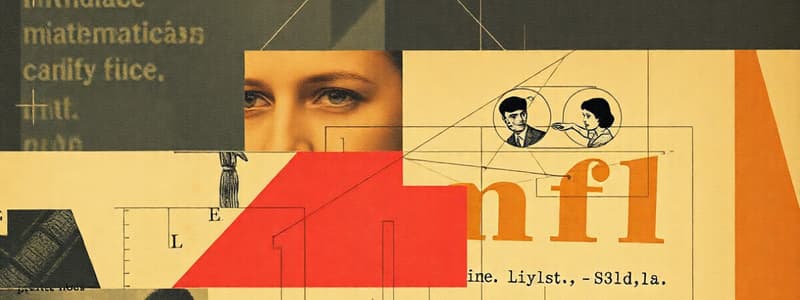Podcast
Questions and Answers
Which of the following best describes the set of all even numbers less than 10?
Which of the following best describes the set of all even numbers less than 10?
- {1, 2, 3, 4, 5, 6, 7, 8, 9}
- {0, 2, 4, 6, 8}
- {2, 4, 6, 8} (correct)
- {1, 3, 5, 7, 9}
The symbol "∩" represents the ______ of two sets.
The symbol "∩" represents the ______ of two sets.
intersection
Match the following sets with their respective notations:
Match the following sets with their respective notations:
{1, 2, 3, 4, ...} = N {0, 1, 2, 3, 4, ...} = W {...-3, -2, -1, 0, 1, 2, 3 ...} = Z {..., -1/3, 1/7, -15, 0.25, 0.99, ..., 7/4, 9/5, ...} = Q
Which of the following sets is an example of a singleton set?
Which of the following sets is an example of a singleton set?
What is the difference between a proper subset and an improper subset?
What is the difference between a proper subset and an improper subset?
The union of two sets always results in a set with more elements than either of the original sets.
The union of two sets always results in a set with more elements than either of the original sets.
Flashcards
Set
Set
A well-defined collection of distinct objects called elements.
Roster Representation
Roster Representation
A list of all elements in a set, enclosed in curly brackets.
Set-Builder Representation
Set-Builder Representation
A description of the elements in a set based on common properties or rules.
Power Set
Power Set
Signup and view all the flashcards
Proper Subset
Proper Subset
Signup and view all the flashcards
Improper Subset
Improper Subset
Signup and view all the flashcards
Universal Set
Universal Set
Signup and view all the flashcards
Set Operations
Set Operations
Signup and view all the flashcards
Study Notes
Sets
- Sets are well-defined collections of objects.
- Elements within a set are not repeated.
- Sets are represented using capital letters and curly brackets.
- Example: A = {1, 2, 3, 4}
Types of Sets
- Empty Set (Null Set): A set with no elements. Represented as Ø or {}.
- Finite Set: A set with a countable number of elements. Example: {1, 2, 3}.
- Infinite Set: A set with an uncountable number of elements. Example: The set of natural numbers.
- Equal Set: Sets with precisely the same elements. Example: A = {1, 2, 3} and B = {1, 2, 3}
- Subset: A set A is a subset of set B, written as A ⊆ B, if every element of A is also an element of B.
- Example: {1, 2} ⊆ {1, 2, 3}
- Superset: Set B is a superset of set A, written as B ⊇ A if every element of A is also an element of B.
- Proper Subset: Set A is a proper subset of set B, written as A ⊂ B, if A is a subset of B, but A is not equal to B.
- Roster Form: Lists all elements within curly brackets.
- Set-Builder Notation: Defines a set using a rule or property that determines set membership. -Example: {x | x is a natural number less than 5}.
Set Operations
- Union (A∪B): Includes all elements from both sets A and B. A∪B = {x | x ∈ A or x ∈ B}
- Intersection (A∩B): Contains elements common to both sets A and B. A∩B = {x | x ∈ A and x ∈ B}
- Difference (A-B): Contains elements in set A that are not in set B. A-B = {x | x ∈ A and x ∉ B}
- Complement (A'): Contains all elements in the universal set (U) that are not in set A. A'= U - A
Set Properties
- Commutative Law: A∪B = B∪A and A∩B = B∩A.
- Associative Law: (A∪B)∪C = A∪(B∪C) and (A∩B)∩C = A∩(B∩C).
- Distributive Law: A∩(B∪C) = (A∩B)∪(A∩C) and A∪(B∩C) = (A∪B)∩(A∪C).
- Idempotent Law: A∪A = A and A∩A = A.
- Identity Law: A∪$ = A and A∩U = A.
- Complement Laws: A∪A’=U and A∩A’ = $.
- De Morgan's Laws: (A∪B)’ = A’∩B’ and (A∩B)’ = A’∪B’.
Intervals
- Intervals are subsets of real numbers
- Example of closed interval: [a, b]={x: a ≤ x ≤ b}
- Example of open interval: (a, b)={x: a < x < b}
Cardinality
- n(A): the number of elements in set A
- n(A∪B) = n(A) + n(B) - n(A∩B)
Venn Diagrams
- Visual representations of sets and their relationships, using overlapping circles.
Additional Information
- Set of natural numbers (N): {1, 2, 3, ...}
- Set of whole numbers (W): {0, 1, 2, 3, ...}
- Set of integers (Z): {..., -3, -2, -1, 0, 1, 2, 3, ...}
- Set of rational numbers (Q): Numbers that can be expressed as a fraction p/q, where p and q are integers and q ≠ 0.
- Set of real numbers (R): Includes all rational and irrational numbers.
- Set of complex numbers (C): Includes real and imaginary numbers.
Studying That Suits You
Use AI to generate personalized quizzes and flashcards to suit your learning preferences.




